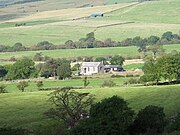Stainmore
| Stainmore | |
| Westmorland | |
|---|---|
 Mousegill, with Great Knipe behind | |
| Location | |
| Grid reference: | NY8314 |
| Location: | 54°31’40"N, 2°15’35"W |
| Data | |
| Population: | 264 (2011) |
| Post town: | Kirkby Stephen |
| Postcode: | CA17 |
| Dialling code: | 01768 |
| Local Government | |
| Council: | Westmorland and Furness |
| Parliamentary constituency: |
Penrith and The Border |
Stainmore is a remote parish and moor of Westmorland, in the fells close to the border of [[the North Riding of Yorkshire, in the Pennines. The name and area encompass the villages of North Stainmore and South Stainmore. The parish had a population of 264 at the 2011 census. Stainmore Forest stretches further east into Yorkshire, towards Bowes.[1]
Geography
Stainmore is drained by the River Belah and the River Balder. It is crossed by the Roman road from Bowes to Brough, now part of the A66, and formerly by the Stainmore Railway. Each of these lines of communication has made use of the relatively low broad saddle between the higher hills to north and south which is commonly referred to as the Stainmore Gap. The Stainmore Summit, the summit of the former railway, is around 1,378 feet above sea level, though the roads climb to slightly higher elevations. The Gap is coincident with the Stainmore Summit Fault which throws the relatively flat-lying Carboniferous rocks of the area down to the south.[2] It acted as a conduit ice originating in the Lake District to pass eastwards during one or more Ice Ages.
There are several 'Regionally Important Geological / Geomorphological Sites' in the Stainmore area, and Bowes Moor is a 'Site of Special Scientific Interest'. The locality gives its name to the Stainmore Trough, a geological structure originating during the Carboniferous period and which lies between the Alston Block to the north and the Askrigg Block to the south.
History
The name 'Stainmore' is first attested in a document of circa 990, where it appears as Stanmoir. It appears as Stanmore in the Charter Rolls for the reign of Henry II, and as Staynmor in the Placita de Quo Warranto of 1292. The name means 'stony moor'.[3]
According to Roger of Wendover, Stainmore was where Eric Bloodaxe (d. 954), recently expelled from York, was betrayed and killed, an event which some historians believe to have taken place in a great battle, known as the Battle of Stainmore.[4]
Ancient monuments on the moor include a Roman marching camp at Rey Cross and, immediately east of the camp, the Rey Cross itself (54°30’20"N, 2°8’55"W), also called Rere Cross (Scheduled monument, no. 32713).[5]
The Ecclesiastical parish of Brough with Stainmore has two churches: St Michael's, Brough under Stainmore and St Stephen's, South Stainmore.[6] St Stephen's was built by Cuthbert Buckell in 1600 and rebuilt by Henry Tufton, 11th Earl of Thanet in 1842-3.[7]
Pictures
| ("Wikimedia Commons" has material about Stainmore) |
References
- ↑ "Kelly's Directory of Westmorland". 1906. http://forebears.co.uk/england/westmorland/stainmore. Retrieved 2 July 2015.
- ↑ British Geological Survey 1:50,000 scale geological map sheet no 31 (England & Wales) Brough-under-Stainmore
- ↑ Ekwall, Eilert, The Concise Oxford Dictionary of English Place-Names. Oxford, Oxford University Press, 4th edition, 1960. p. 436 ISBN 0198691033
- ↑ Roger of Wendover's Flowers of History, Comprising the History of England from the Descent of the Saxons to A. D. 1235 Formerly Ascribed to Matthew Paris, trans. by J. A. Giles, 2 vols (London: Bohn, 1849), I, 256 (s.a. 950) https://archive.org/details/rogerofwendovers01rogemiss.
- ↑ "Roman Marching Camp Rey Cross, Durham". Archived from the original on 19 February 2015. https://web.archive.org/web/20150219211058/http://www.roman-britain.org/places/rey_cross.htm.
- ↑ "Brough with Stainmoor". http://www.achurchnearyou.com/parish/570010/. Retrieved 20 June 2015.
- ↑ "St Stephens Church (Stainmore St Stephen)". http://www.achurchnearyou.com/stainmore-st-stephen/st-stephens-church.html. Retrieved 20 June 2015.
- Collingwood, W.G. (1927), "Rey-Cross", Transactions of the Cumberland and Westmorland Antiquarian and Archaeological Society, Series 2 (27): 1–10, https://archaeologydataservice.ac.uk/archiveDS/archiveDownload?t=arch-2055-1/dissemination/pdf/Article_Level_Pdf/tcwaas/002/1927/vol27/tcwaas_002_1927_vol27_0003.pdf
- Ramsden, D.M. (1948), From Stainmore to the Tees, Dalesman
- Richmond, I.A.; McIntyre, J. (1934), "The Roman marching camps at Reycross and Crackenthorpe", Transactions of the Cumberland and Westmorland Antiquarian and Archaeological Society, Series 2 (34): 50–61, https://archaeologydataservice.ac.uk/archiveDS/archiveDownload?t=arch-2055-1/dissemination/pdf/Article_Level_Pdf/tcwaas/002/1934/vol34/tcwaas_002_1934_vol34_0011.pdf
- Robinson, Pip; Vyner, Blaise (1993), Archaeology on the Stainmore Pass – the A66 Project, English Heritage, ISBN 0 9520836 1 2, https://archaeologydataservice.ac.uk/library/browse/issue.xhtml?recordId=1108602&recordType=GreyLitSeries
- Vyner, Blaise; Robinson, Pip; Annis, R. G.; Pickin, John (2001), Stainmore. The Archaeology of a North Pennine Pass, Tees Archaeology Monographs 1 and English Heritage, ISBN 0 9532747 0 5







